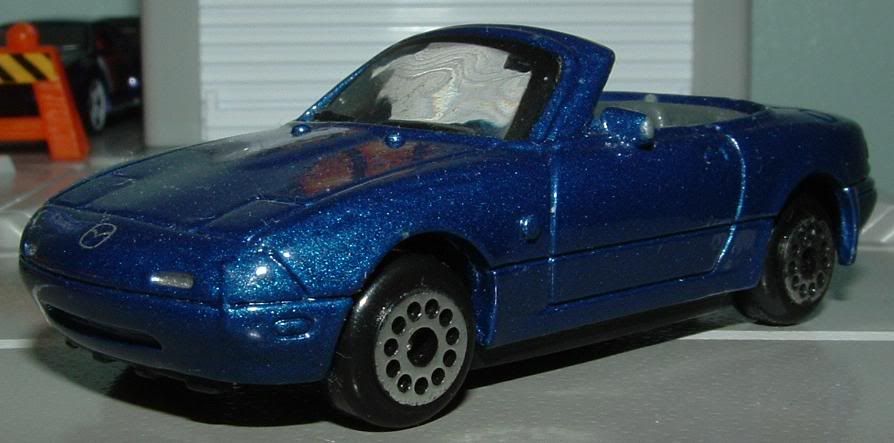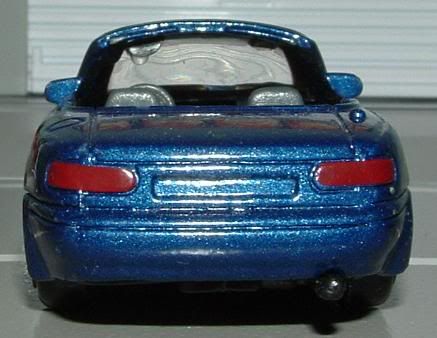
A blog focusing on 1/64 diecast from such popular brands as Hot Wheels, Matchbox, Johnny Lightning, M2 Machines, GreenLight, Tomica, Yat Ming, Majorette, MotorMax, Siku, Corgi, Guisval, Playart, Ertl, Zylmex, Racing Champions, & many more. Swifty's Garage features a daily Car Of The Day and news updates from your favorite brands!
Friday, May 6, 2011
Car Of The Day: May 6, 2011
Today's car of the day is MotorMax's 1996 Mazda MX-5 Miata.
The MX-5, also known as Miata in North America and Eunos Roadster in Japan, is a lightweight two-seater roadster, of front-engine, rear-wheel drive layout, built by Mazda in Hiroshima, Japan. The model was introduced in 1989 at the Chicago Auto Show. The MX-5 was conceived as a small roadster – with light weight and minimal mechanical complexity limited only by legal and safety requirements; technologically modern, but a philosophically direct descendant of the small British roadsters of the 1960s such as the Triumph Spitfire, Austin-Healey Sprite, MG Midget and Lotus Elan.
The second generation MX-5 (NB) was launched in 1998 and the current (NC) model having been in production since 2006, and it continues to be a best selling convertible, and by February 2011, 900,000 MX-5s have been built and sold around the world.
Since the launch of the third generation MX-5, Mazda consolidated worldwide marketing using the MX-5 name, though enthusiasts in the USA still refer to it as Miata, a name that means "reward" in Old High German.
For more information and pictures of the real car please visit: Mazda MX-5 Miata
This is one of the nicest first generation Miata castings- superior in my opinion to the Tomica, but I rank the Hot Wheels slightly above it because Hot Wheels actually made theirs tiny.
The MX-5 was unveiled at the Chicago Auto Show on February 10, 1989, with a price tag of US$14,000 (US$24,100 in 2008 adjusted for inflation). The MX-5, with production code NA, was made available for delivery to buyers worldwide in the following dates: March 1989 in Japan; May 1989 (as a 1990 model) in the USA and Canada; and 1990 in Europe. An optional hardtop was made available at the same time, in sheet moulding compound (SMC). Demand initially outstripped production, fueled by enthusiastic press reviews.
In Japan, the car was not badged as a Mazda, as the company was experimenting with the creation of different marques for deluxe models, similar to Nissan's Infiniti and Toyota's Lexus (both brands of which launched at the same time as the Miata). Instead, the Mazda MX-5 was sold as the Eunos Roadster in that market.
The body shell of the NA was all-steel with a light-weight aluminium hood. Overall dimensions were 3,970 mm (156 in) in length, 1,675 mm (65.9 in) in width, and 1,235 mm (48.6 in) in height. Without options, the NA weighed only 2,150 lb (980 kg). Drag coefficient was indicated as 0.38. Suspension was an independent double wishbone on all four wheels, with an anti-roll bar at the front and rear. Four wheel-disc brakes, ventilated at the front, were behind alloy wheels with 185/60HR14 radial tires. The base model came with stamped steel wheels from the then-current 323/Protege.
The original MX-5 came with a 1.6 L (98 cu in) dual overhead cam inline four-cylinder engine, producing 86 kW (115 bhp) at 6,800 rpm, and 136 N·m (100 lbf·ft) of torque at 5,500 rpm. The engine employs an electronic fuel injection system using a vane-type air flow meter and an electronic ignition system with a camshaft angle sensor instead of a distributor. This engine, codename B6ZE(RS), was specifically designed for the MX-5 and featured a lightened crankshaft, flywheel, and aluminum sump with cooling fins.
Standard transmission was 5-speed manual. In Japan and the USA, an optional automatic transmission was also offered but proved to be unpopular. The Japanese and American markets also received an optional viscous limited slip rear differential, although it was only available for cars with a manual transmission. To achieve the low introductory price, the base model was stripped. It had steel wheels, manual steering, roll-up windows, and no stereo or air-conditioning. Power steering, air-conditioning, and stereo were added as standard equipment in later years.
The NA could reach 60 mph (97 km/h) in 7.9 seconds and had a top speed of 130 mph (210 km/h). This first generation of Miata (often referred to as the NA) included a special edition in 1991, produced in British Racing Green with the first use of tan interior.
1500 LE (Limited Edition) cars were produced in 1993. This model featured red leather interior, upgraded stereo, Nardi shift knob, leather wrapped steering wheel, cruise, limited slip differential, power windows, power mirrors, power steering, air conditioning, BBS wheels, Bilstein shocks, front and rear spoilers, ABS brakes, stainless sill plates, and Harley style peanut tank door speaker trim. All 1993 LE cars came in black.
For the 1994 model year, the first-generation MX-5 was freshened with the introduction of the more powerful 1.8 L (110 cu in) BP-ZE engine, dual airbags and a limited slip differential in some markets. The chassis was substantially braced to meet new side-impact standards, most visibly by adding a "track bar" between the seatbelt towers inside the car, but also to the front and rear subframes. Also, 1994 and 1995 were the only years in which Mazda offered a light metallic blue paint (Laguna Blue Mica), making these cars rare collectors cars to some. 1994 also saw the introduction of the "R" package, a sport-themed package with Bilstein shocks and subtle underbody spoilers, in addition to the removal of unnecessary items such as power steering. No body style changes were made, however.
The new 1.8 L (110 cu in) engine produced 98 kW (131 bhp), which was then increased to 99 kW (133 bhp) for the 1996 model year. The base weight increased to 990 kg (2,200 lb). Performance was improved slightly, the additional power being partly offset by the extra weight. In some markets such as Europe, the 1.6 L (98 cu in) engine continued to be available as a lower-cost option, but was detuned to 66 kW (89 bhp). This lower-powered model did not receive all the additional chassis bracing of the new 1.8 L (110 cu in). Japanese and US cars were fitted with an optional Torsen LSD, which was far more durable than the previous viscous differential.
There were a number of trim levels and special editions available, determined by local Mazda marketing departments. In the US, the base model was offered for US$13,995 at launch and was very basic, with manual windows, steel wheels, and without A/C or power steering. The "A Package" offered power steering, a leather-wrapped steering wheel, aluminum alloy wheels and cassette stereo. The "B Package" added power windows, along with cruise control and headrest speakers, while the "C Package" included a tan interior and top and leather seats. The "R Package" was for racing, and the annual special editions were formalized as "M Editions". These included all of the luxury options from the "C Package" as well as special paint and, sometimes, special wheels. In the UK, to celebrate Mazda's 24 hours of Le Mans win, Mazda brought out a special edition of the MX-5, with the winner's color scheme (see Mazda 787B) and came equipped with BBR (Brodie Brittain Racing) turbo conversion; the car is one of the most sought after special edition cars of the MX-5s.
The first generation MX-5 was phased out with the 1997 model year (with the exception of 400 limited edition Berkeley models sold only in the UK in 1998 to mark the end of the NA), with the final 1500 NAs produced for the US market being the "STO" ("Special Touring Option") versions.
Subscribe to:
Post Comments (Atom)






No comments:
Post a Comment